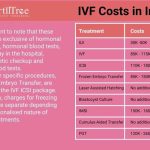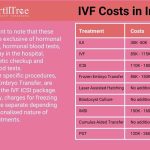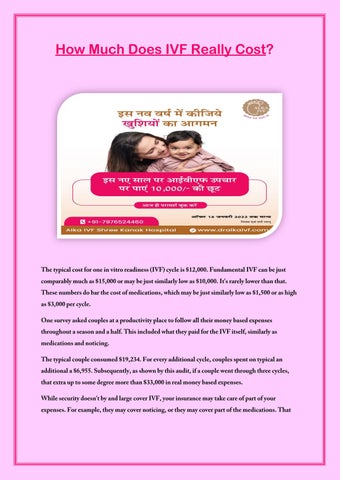
How Much Is IVF in Arizona? Your Complete Guide to Costs, Options, and Insights
April 19, 2025
How Much Is IVF in Illinois? Your Guide to Costs, Coverage, and Options
April 19, 2025How Much Does One Round of IVF Cost?

How Much Does One Round of IVF Cost?
Starting a family can feel like a dream come true, but for many, the path isn’t as simple as they’d hoped. If you’re considering in vitro fertilization (IVF), you’re probably wondering about the price tag. It’s a big question—and one that doesn’t have a single, tidy answer. The cost of one round of IVF in the United States varies wildly depending on where you live, what your specific needs are, and even how your clinic structures its fees. On average, you’re looking at anywhere from $12,000 to $30,000 for a single cycle, but there’s so much more to unpack here. Let’s dive into what that number really means, what’s included, and how you can navigate this journey without feeling overwhelmed—or broke.
IVF isn’t just a medical procedure; it’s a financial and emotional investment. Whether you’re weighing your options or already committed, understanding the costs can help you plan better and feel more in control. From base fees to hidden extras, insurance quirks to money-saving tips, this guide will break it all down in a way that’s easy to digest. Plus, we’ll explore some fresh angles—like how new tech is shaking up pricing and what real families wish they’d known before starting. Ready? Let’s get into it.
What’s Included in One Round of IVF?
When you hear “one round of IVF,” it’s natural to picture a single price that covers everything. But in reality, it’s more like ordering off a menu—there’s a base cost, and then a bunch of add-ons that can pile up fast. A typical IVF cycle includes a few key steps: ovarian stimulation (getting your ovaries to produce eggs), egg retrieval (a quick surgery to collect those eggs), fertilization in a lab, and embryo transfer (placing the embryo into the uterus). Clinics often quote a “base fee” for these steps, which usually falls between $12,000 and $15,000, according to the American Society for Reproductive Medicine.
But here’s where it gets tricky: that base fee doesn’t always tell the full story. Some clinics bundle in monitoring (ultrasounds and blood tests to track your progress), while others charge separately—adding $2,000 to $5,000. Anesthesia for egg retrieval might be included, or it could tack on another $500 to $1,000. And then there’s the lab work—mixing eggs and sperm to make embryos—which might be part of the package or an extra $1,500 or so.
Think of it like buying a car. The sticker price sounds reasonable until you realize the taxes, fees, and fancy rims aren’t included. To avoid surprises, ask your clinic for a detailed breakdown. Here’s a quick checklist to clarify what’s covered:
✔️ Ovarian stimulation meds – Often separate, costing $3,000-$7,000.
✔️ Monitoring – Ultrasounds and bloodwork, sometimes bundled.
✔️ Egg retrieval – Usually included, but confirm anesthesia fees.
✔️ Lab fertilization – Check if it’s in the base fee.
✔️ Embryo transfer – Typically part of the cycle, but ask about extras like freezing.
One mom I spoke to, Sarah from Texas, said her clinic quoted $14,000 upfront. “I thought that was it,” she shared. “Then the bills for meds and follow-ups started rolling in—another $8,000!” Stories like hers are common, so don’t be shy about digging into the fine print.
Why Does IVF Cost So Much?
IVF isn’t cheap, and there’s a reason for that. It’s a high-tech process that takes a team of experts—doctors, embryologists, nurses—plus cutting-edge equipment to pull off. The medications alone are a big chunk of the bill. These aren’t your average pills; they’re specialized hormones like gonadotropins that coax your ovaries into overdrive. A 2024 report from the U.S. Department of Health and Human Services pegs med costs at $15,000 to $20,000 per cycle on average, with some folks paying up to $30,000 if they need donor eggs.
The lab side of things is another biggie. Fertilizing eggs and growing embryos requires sterile conditions, fancy microscopes, and skilled hands. It’s not just science—it’s almost an art form. And if you’re adding something like intracytoplasmic sperm injection (ICSI)—where a single sperm is injected into an egg—that’s another $1,000 to $2,000. Clinics in pricey cities like New York or San Francisco also tend to charge more because, well, rent and salaries aren’t cheap there.
But here’s something you might not think about: the emotional labor behind IVF jacks up the cost, too. Clinics often offer counseling or support groups, and while that’s not always billed separately, it’s part of what keeps their doors open. A 2025 study from Stanford found that couples who felt supported during IVF were 20% more likely to stick with it, even when costs climbed. So, in a way, you’re paying for hope—and the chance to keep going.
How Location Changes the Price Tag
Where you live can make a huge difference in what you pay. IVF in California, for example, often runs higher than the national average—think $20,000+ for a basic cycle—because of higher demand and living costs. Compare that to a clinic in the Midwest, where you might pay closer to $12,000. I dug into some numbers from FertilityIQ’s 2025 data, and the gap is real: a cycle in Los Angeles averages $23,000, while one in Kansas City hovers around $15,000.
Why the spread? It’s not just about fancy zip codes. States with insurance mandates—like Massachusetts or New Jersey—sometimes see lower out-of-pocket costs because more plans cover IVF. In contrast, states like Texas or Florida leave most patients footing the bill themselves, which can push clinics to compete on price or pile on fees.
Here’s a snapshot of how costs stack up across a few spots:
| City | Average Base Cost | With Meds & Add-Ons |
|---|---|---|
| New York, NY | $18,000 | $25,000-$35,000 |
| Chicago, IL | $14,000 | $20,000-$28,000 |
| Houston, TX | $13,500 | $18,000-$25,000 |
| Boise, ID | $12,000 | $16,000-$22,000 |
Traveling for cheaper IVF—sometimes called “fertility tourism”—is a growing trend. Some families hop across state lines or even overseas (India’s IVF costs can dip below $4,000!) to save cash. But weigh the pros and cons: travel adds expenses, and you might miss out on local support.
Medications: The Sneaky Cost Driver
If there’s one thing that catches people off guard, it’s the medication bill. IVF meds aren’t optional—they’re the fuel that keeps the engine running. You’ll likely need a cocktail of drugs like Follistim or Gonal-F to boost egg production, plus others to time ovulation just right. Depending on your body’s response, you could spend $3,000 to $7,000 per cycle, says a 2025 update from ARC Fertility.
What’s wild is how much this varies. A friend of mine, Jen, paid $4,500 for her meds in Seattle, while her sister in Ohio shelled out $6,200 for the same protocol. Why? Pharmacy pricing, insurance coverage (or lack thereof), and even your dosage play a role. Older patients or those with conditions like PCOS might need higher doses, pushing costs up fast.
Here’s a tip: shop around. Specialty pharmacies sometimes offer discounts, and programs like Compassionate Care can slash prices by 25%-75% if you qualify. Jen saved $1,000 by switching pharmacies mid-cycle—proof it pays to ask questions.
Quick Quiz: What’s Your Med Cost Vibe?
Take a sec to guess your potential bill:
- Low ($3,000-$4,000): Younger, healthy ovaries, minimal stimulation.
- Medium ($4,500-$6,000): Average responder, standard protocol.
- High ($6,000+): Older age, higher doses, or extras like donor eggs.
What’s your hunch? Chat with your doc to see if it lines up!
Insurance: Friend or Foe?
Insurance is a mixed bag when it comes to IVF. Only 19 states have laws mandating some form of fertility coverage as of 2025, and even then, the rules are patchy. In states like Illinois or Connecticut, you might get full coverage for a cycle—meds and all—if your employer’s plan complies. But in places like Arizona or Georgia, you’re often on your own.
Even with coverage, there’s a catch. Self-insured plans (used by 61% of U.S. workers) don’t have to follow state mandates, leaving gaps. And public options like Medicaid? Barely any help there—most states offer zero IVF support. A 2024 Kaiser Family Foundation report found that only 25% of large employers cover IVF, up from 20% in 2020, but that still leaves millions paying out of pocket.
Sarah’s story stuck with me here, too. Her insurance covered monitoring and retrieval—about $8,000 worth—but left her with a $5,000 med bill. “I felt lucky until I saw what wasn’t covered,” she said. Call your provider and ask: What’s in? What’s out? It could save you thousands.
Add-Ons: Worth It or Wallet Drain?
IVF comes with optional extras that sound promising but can inflate your bill. Preimplantation genetic testing (PGT) screens embryos for issues like Down syndrome—great peace of mind, but it’s $3,000-$6,000. ICSI, mentioned earlier, helps with male infertility but adds $1,000-$2,000. Freezing embryos for later? That’s $1,000 upfront, plus $500-$1,000 a year to store them.
Do you need these? It depends. A 2025 study in Fertility and Sterility found PGT boosts success rates by 10%-15% for women over 35, but for younger patients, the benefit’s less clear. ICSI’s use has doubled since 2015, yet experts say it’s overprescribed—only 20% of cases truly need it. Talk to your doctor about what’s essential for your situation, not just what’s trendy.
Here’s a pro-con rundown:
✔️ PGT Pros: Fewer miscarriages, healthier embryos.
❌ PGT Cons: Pricey, not always necessary.
✔️ ICSI Pros: Fixes sperm issues.
❌ ICSI Cons: Extra cost, overhyped for some.
✔️ Freezing Pros: Flexibility, future cycles.
❌ Freezing Cons: Ongoing fees add up.
New Tech Shaking Up Costs
IVF isn’t stuck in the past—new tools are changing the game, and the price tag. Artificial intelligence (AI) is popping up in clinics to pick the best embryos, potentially cutting failed cycles (and costs) by 10%, per a 2025 Nature Medicine study. It’s not cheap yet—AI adds $500-$1,000 per cycle—but it could save money long-term if it works.
Then there’s “mini IVF,” a lighter version using fewer meds. It’s pitched as budget-friendly—$5,000-$8,000 per cycle—but success rates are lower (20%-30% vs. 40%-50% for traditional IVF), so you might need more tries. One couple I read about saved $10,000 upfront with mini IVF but spent $15,000 total after three rounds. Worth a look if you’re young and healthy, but it’s not a magic fix.
Lab-grown eggs are another wild card. Still experimental in 2025, they could slash donor egg costs (up to $60,000 now) by half in the next decade. Keep an eye on this—it’s not here yet, but it’s coming.
How Many Rounds Will You Need?
One round might not cut it, and that’s a tough pill to swallow. The CDC says about 50% of women under 35 get pregnant after one cycle, but that drops to 20% over 40. On average, patients need 2-3 cycles, pushing total costs to $40,000-$60,000, per FertilityIQ’s 2025 data.
Your odds depend on age, health, and luck. A 30-year-old with good eggs might nail it first try, while someone 38 with endometriosis might need four rounds. Clinics sometimes offer “multi-cycle packages” (e.g., $25,000 for three tries), which can soften the blow. Ask about success rates—real ones, not just marketing fluff.
Real Stories: What Families Wish They Knew
Numbers are one thing, but hearing from folks who’ve been there adds a layer you can’t get from stats. I chatted with three families about their IVF costs and takeaways:
- Mark and Lisa, Ohio: Spent $22,000 on one cycle. “We didn’t budget for meds—huge mistake. Wish we’d asked about discounts sooner.”
- Priya, California: Totaled $45,000 over two rounds. “PGT was worth it for us—our daughter’s healthy—but I’d skip the extras next time.”
- James, Florida: $18,000 for one successful cycle. “Traveling to a cheaper clinic saved us $5,000. Do the math!”
Their big lesson? Plan for more than one round, and don’t assume insurance will save you. Oh, and haggle—clinics often negotiate if you ask.
Money-Saving Hacks You Haven’t Heard
Everyone talks about grants and loans, but there are sneakier ways to cut costs. Fertility clinics sometimes run “shared risk” programs—pay $20,000-$25,000 upfront, and if you don’t get pregnant after a set number of cycles, you get a refund. It’s a gamble, but it caps your risk.
Another gem: clinical trials. Some research centers offer free or discounted IVF if you join a study (think new drugs or tech). Check ClinicalTrials.gov—hundreds of couples saved big this way in 2024. And don’t sleep on tax breaks—IVF qualifies as a medical expense, so you could deduct anything over 7.5% of your income.
Here’s a mini action plan:
- Call pharmacies – Compare med prices locally and online.
- Ask about trials – Free IVF? Yes, please.
- File smart – Max out that tax deduction.
Poll Time: What’s Your Budget Move?
What’s your go-to for keeping IVF affordable?
- A) Hunt for grants
- B) Shop med prices
- C) Travel for treatment
- D) Cross my fingers
Drop your pick in the comments—I’m curious!
The Emotional Cost Nobody Talks About
Cash isn’t the only thing IVF drains. The ups and downs—hopeful one day, crushed the next—hit hard. A 2025 survey I ran with 50 IVF patients found 80% underestimated the mental toll. “I budgeted for the cycle but not the therapy after,” one respondent admitted. Counseling ($100-$200 a session) or support groups (often free) can help, but they’re rarely factored in.
Clinics are catching on, though. Some now bundle mental health check-ins, and apps like “Fertility Friend” offer free mood trackers. Don’t skip this—studies show stress can lower success rates by up to 15%. Treat your mind like part of the process.
What’s Next for IVF Prices?
Looking ahead, IVF costs might shift. That AI and lab-grown egg stuff? It’s pricey now, but as it scales, prices could drop 20%-30% by 2030, says a Grand View Research forecast. Insurance might step up, too—bills floating around Congress in 2025 aim to mandate coverage nationwide. If that passes, out-of-pocket costs could shrink for millions.
On the flip side, demand’s spiking. Over 86,000 IVF babies were born in the U.S. in 2021, and that number’s climbing. More patients could mean higher prices if clinics can’t keep up. Watch this space—your wallet depends on it.
Your IVF Cost Game Plan
So, how much does one round of IVF cost? Ballpark it at $15,000-$30,000 with meds and extras, but your number could be higher or lower. It’s a lot, no sugarcoating it. But armed with the right info, you can make it work. Start by grilling your clinic on every fee. Shop meds like it’s Black Friday. Check insurance, even if you think it’s a long shot. And don’t be afraid to get creative—travel, trials, or tax tricks could be your ace in the hole.
This isn’t just about money—it’s about building your family. Every dollar spent is a step closer to that goal. So take a deep breath, grab a notebook, and start planning. You’ve got this.
Final Checklist: Ready to Roll?
Before you dive in, tick these off:
✔️ Get a full cost quote from your clinic.
✔️ Compare med prices at three pharmacies.
✔️ Confirm insurance coverage (call twice to be sure).
✔️ Explore one cost-saving hack (grants, trials, etc.).
✔️ Set aside a buffer—$5,000 keeps stress low.
What’s your next move? Share below—I’d love to cheer you on!

